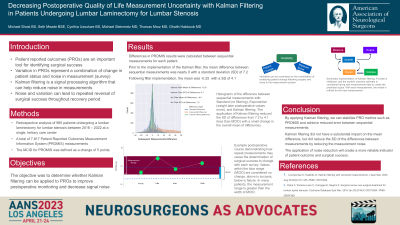Decreasing Postoperative Quality of Life Measurement Uncertainty with Kalman Filtering in Patients Undergoing Lumbar Laminectomy for Lumbar Stenosis
Friday, April 21, 2023


Michael Shost
Medical Student
Case Western Reserve University School of Medicine
Cleveland Heights, Ohio, United States
ePoster Presenter(s)
Introduction: Patient reported outcomes (PROs) are an important tool for identifying surgical success; however, the inherent variability of PROs makes interpretation difficult and limits their role in clinical practice. While improvements in a PRO greater than the declared minimally clinically important difference (MCID) are deemed a “success” and deterioration below the MCID is a “failure”, our prior work showed that over 10% of patients demonstrate reversal of these surgical outcomes during their recovery. This variability arises from changes in a patient’s condition as well as measurement noise. This study utilizes a signal processing algorithm called Kalman filtering to process PRO data and improve its stability over time and thus its usefulness in the assessment of patient-reported quality of life during the postoperative period.
Methods: Retrospective analysis of patients undergoing lumbar laminectomy for lumbar stenosis between 2016 – 2022 identified 985 patients at a single institution. A total of 7817 Patient Reported Outcomes Measurement Information System (PROMIS) measurements were collected. The MCID for PROMIS scores is 5. Python was used to construct the linear Kalman filter using custom functions and the base python numerical library, “numpy”.
Results: Differences in PROMIS results were calculated between sequential measurements for each patient. Prior to the implementation of the Kalman filter, the mean difference between sequential measurements was nearly 0 (standard deviation (SD) = 7.2). Following filter implementation, the mean was -0.25 (SD = 4.1).
Conclusion : By applying Kalman filtering, we can stabilize metrics like PROMIS and achieve reduced error between sequential measurements. Continued application of Kalman filtering in PROs can decrease noise and variability through the integration of multiple data streams and enable refined estimates of current patient status that clinicians can follow in near real-time to monitor the course of recovery.
Methods: Retrospective analysis of patients undergoing lumbar laminectomy for lumbar stenosis between 2016 – 2022 identified 985 patients at a single institution. A total of 7817 Patient Reported Outcomes Measurement Information System (PROMIS) measurements were collected. The MCID for PROMIS scores is 5. Python was used to construct the linear Kalman filter using custom functions and the base python numerical library, “numpy”.
Results: Differences in PROMIS results were calculated between sequential measurements for each patient. Prior to the implementation of the Kalman filter, the mean difference between sequential measurements was nearly 0 (standard deviation (SD) = 7.2). Following filter implementation, the mean was -0.25 (SD = 4.1).
Conclusion : By applying Kalman filtering, we can stabilize metrics like PROMIS and achieve reduced error between sequential measurements. Continued application of Kalman filtering in PROs can decrease noise and variability through the integration of multiple data streams and enable refined estimates of current patient status that clinicians can follow in near real-time to monitor the course of recovery.
